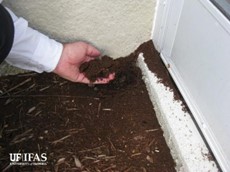
by Donna Arnold | Sep 25, 2025
When the Ground Moves.
It started with a quiet day, and a curious bag of sand brought into the extension office but inside was more than just sand. It was crawling with tawny crazy ants (Nylanderia fulva), one of Florida’s fastest-spreading invasive pests. Known for their erratic movement and massive colonies that can make the ground seem alive, these reddish-brown ants are now a growing concern for gardeners across some Florida counties. Unlike fire ants, tawny crazy ants don’t sting, but they can nip with their chewing mouthparts. Their sheer numbers can overwhelm outdoor spaces, crawling on people and spoiling the enjoyment of patios, gardens, and recreational areas. They nest in moist, protected areas such as leaf litter, potted plants, and under debris, often forming sprawling colonies with multiple queens.
Beyond being a nuisance, these ants pose serious risks. They’ve been known to cause electrical shortages by infiltrating equipment, sometimes leading to costly damage. In some Caribbean islands, they’ve harmed organic crops, and in Colombia, infestations have even led to the death of small animals due to asphyxiation. Larger animals have been attacked around sensitive areas like the eyes and hooves. Tawny crazy ants also disrupt local ecosystems. Their aggressive spread displaces native ant species and reduces biodiversity. While Florida hasn’t reported agricultural damage yet, the potential remains, especially in organic farming systems.

Identification Tips
Workers are small (less than 1/8 inch), monomorphic, and covered in fine hairs that give them a matte appearance. They have one petiole segment and 12 antennal segments, including a long first segment called the scape. Colonies don’t form mounds but may tunnel in sandy soil. Queens are often found among workers, especially in warmer months. If you suspect an infestation, contact your local UF/IFAS Extension office.

Management Challenges
Controlling tawny crazy ants is notoriously difficult. Spraying alone is ineffective, and most insecticides only work for a few days before ants’ return. Integrated Pest Management (IPM) is the recommended approach. IPM combines multiple tactics, starting with accurate identification and monitoring, followed by strategic product application and habitat modification. Professional pest control services that specialize in IPM are often necessary. Timing is critical, and overuse of products is not only ineffective but may violate legal limits. Keep records of infestation locations to anticipate reinvasion, which typically occurs annually. While complete eradication is unlikely in established areas, population suppression is achievable. Interestingly, research suggests that within about a decade, populations may naturally decline, allowing native species to rebound.
Tawny crazy ants are more than just a backyard annoyance they are a complex ecological and household threat. Awareness, early identification, and professional management are key to minimizing their impact. As these ants continue to spread, staying informed and proactive will help protect your property and Florida’s delicate ecosystems.
For more information call or visit your local extension office or follow the link below.
https://edis.ifas.ufl.edu/publication/IN1076

by Evan Anderson | Jul 27, 2025
The warm Florida climate makes it a biologically diverse place, with plants and animals from all over the world finding a foothold here. Some are benign, while others can become pests that harm the environment or get in the way of human activities. One such pest is the red imported fire ant, a visitor from South America. Introduced to North America somewhere in the 1930s or 1940s, these ants are native to a region of savannas and wetlands, where the rainy season brings flooding part of the year. Finding a similar climate along the Gulf coast after hitching a ride on ships, what these ants did NOT find were predators that could keep their populations in check. They have since spread throughout the southeast, and are predicted to make their way up the east coast as far as Maryland, west into Texas before it becomes too dry for them to live comfortably, and even along the Pacific coast of the United States.

A red imported fire ant.
Though they are called ‘red’, their coloration is often reddish-brown with a darker abdomen. Populations in different areas may vary in their particular shade of color. They range in size from 1/8 to ¼ inch in length. A characteristic identifier for this species of ant is their mounds. These are not just regular anthills, where workers digging tunnels belowground dump grains of soil in a pile. Fire ant mounds help the colony regulate temperatures and moisture levels. They are often constructed in open, sunny locations. Disturbing a mound will cause the ants within it to swarm, with hundreds of ants suddenly ready to sting anything around. Their sting usually leaves a white pustule on the skin, coupled with an intense burning or itching sensation. Being attacked by fire ants is one of the least fun things you can do in a garden or landscape.

A fire ant mound.
How do we get rid of fire ants? It is important to understand that fire ants don’t live alone. They are dependent on their colony, where workers forage for food, soldiers protect the nest, and the queen (or queens – fire ant nests have been known to have multiple queens) lays eggs. The queen remains sheltered inside the nest, and until she is gone, the nest can replace its workers. Therefore, any treatment must effectively remove the queen.
Home remedies are often ineffective. Pouring boiling water over ant mounds can damage the colony, but may not reach deep enough into the mound to kill the queen. Applying dry grits to a mound will not harm the ants. Other remedies, such as club soda, simply do not work, and while gasoline and other harsh chemicals might kill some ants, they are not guaranteed to kill the queen. They are likely to cause contamination of the groundwater, however.
What are effective are insecticides, formulated as baits or mound drenches or treatments. Baits are taken by the workers back into the nest, where they are fed to the queen. Mound treatments, when properly applied, soak into the mound and are able to penetrate deeply enough to eliminate the colony. Read the label of any product you choose carefully and follow the instructions.
For more information, see our EDIS fact sheet here:
ENY226/LH059: Managing Imported Fire Ants in Urban Areas
Evan Anderson
Walton County Horticulture Agent

by Larry Williams | Jun 26, 2025
If you’ve been outside this spring, you’ve probably been bothered by gnats. These tiny flies relentlessly congregate near the face getting into the eyes, nose, mouth and ears.
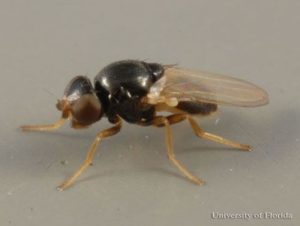
Eye gnat. Credit: Lyle Buss, UF/IFAS
Eye gnats come right up to the faces of people and animals because they feed on fluids secreted by the eyes, nose and ears. Even though eye gnats are considered mostly a nuisance, they have been connected to transmission of diseases such as pink eye.
Eye gnats are true flies. At about one-sixteenth of an inch in length, they are among the smallest fly species in Florida. They are known as eye gnats, eye flies, frit flies and grass flies. The name grass flies is somewhat descriptive as open grass areas such as pastures, hay fields, roadsides and lawns provide breeding sites for these gnats. They also breed in areas of freshly disturbed soil with adequate organic matter such as livestock farms.
Even though these gnats can be found in much of North and South America, they prefer areas with warm, wet weather and sandy soils. Sounds like Florida.
An early spring and plenty of rain are the more likely reasons why these gnats are such a problem in our area this year. Without having the typical last killing frost around mid-March and with early warm weather and rains, the gnats got off to an early start.
Short of constantly swatting them away from your face or just not going outdoors, what can be done about these irritating little flies? I grew up in an area of Georgia where gnats are common. I’ll let you in on a secret, folks who live in Georgia are known to be overly friendly because they are always waving at people who are just passing through. More than likely, these “friendly” folks are busy swatting at gnats, not waving at others who happen to be driving by. Swatting is a quick swinging action with hand as if waving.
Because of their lifecycle, extremely high reproductive numbers in the soil and because insecticides breakdown quickly, area-wide chemical control efforts don’t work well in combating this insect.
The use of the following where gnats are common can be helpful.
- Correct use of insect repellents, particularly those containing DEET
- Screens on windows to prevent the entry of gnats into homes
- Face-hugging sunglasses or other protective eyewear
- Face masks
We may have to put up with these annoying gnats until cold weather arrives and be thankful that they don’t bite.
Additional info on eye gnats is available online at https://edis.ifas.ufl.edu/in884 or from the UF/IFAS Extension Office in your County.
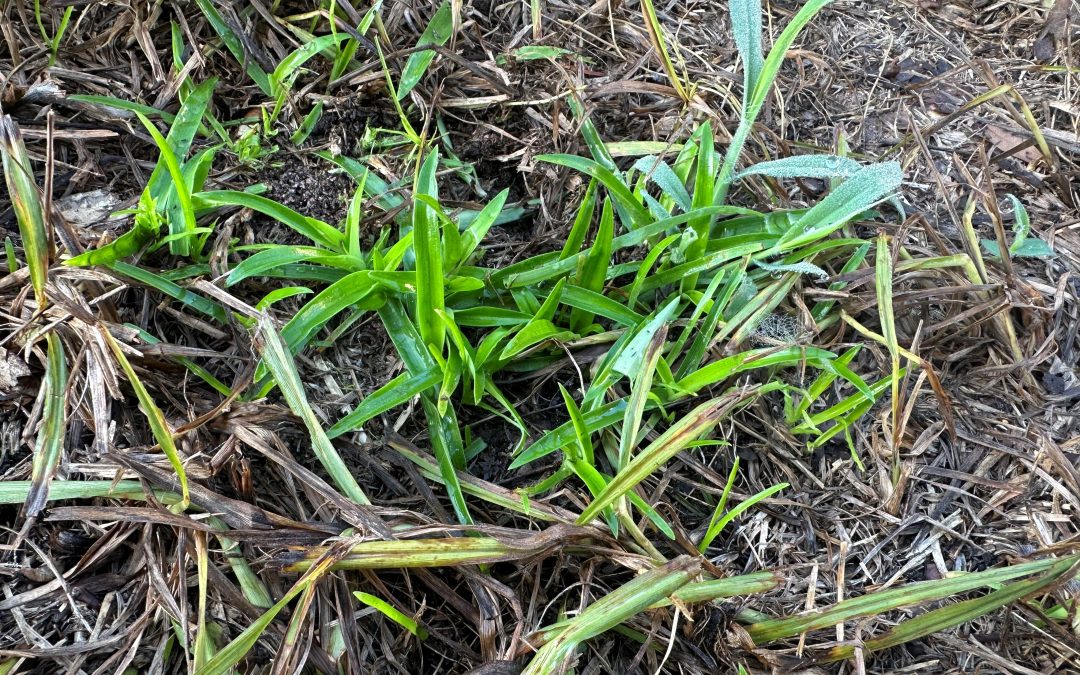
by Daniel J. Leonard | Jun 5, 2025
The Panhandle’s dreaded summer heat has finally arrived in force and has brought with it one of the most difficult to control lawn/landscape weeds, our annual enemy Doveweed (Murdannia nudiflora). Doveweed is characterized as one of the world’s worst weeds due to its broad range of growing conditions, ability to root along its stems, forming mats as it grows, massive seed production (each plant can produce up to 2,000 seeds per year), and inconspicuous nature – it looks like a grass to the untrained eye. So, what can gardeners do to control Doveweed that’s already up this year and prevent it next summer? Let’s find out.
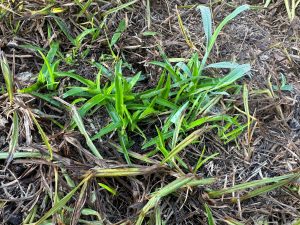
Doveweed emerging in a bare patch of a Centipedegrass lawn in late May 2025. Photo courtesy of Daniel Leonard.
First, the best prevention for all weeds, Doveweed included, is a healthy lawn/landscape. Ensuring healthy, thick Centipedegrass turf and landscaped beds that don’t allow light to hit bare soil goes a long way towards reducing the overall weed load lawns and landscapes can experience. For lawns, this can be achieved through mowing regularly at the proper height for your turfgrass (2.5” or so for Centipedegrass), irrigating no more than 0.75”-1” per week in the absence of rain, limiting stress from overfertilization, and removing excess thatch. In landscapes, preventative weed control focuses on limiting overwatering/fertilization and maintaining a 2-3” organic mulch layer of pinestraw, pine bark, leaves, wood chips, etc. Adopting these practices can greatly reduce the occurrence of weeds in your yard, however they will not eliminate weeds altogether and supplemental chemical weed control is often necessary.
Unlike Crabgrass, Florida Pusley, and other commonly encountered Panhandle annual weeds that emerge when the soil begins to warm in early spring (usually late February-March), Doveweed waits until mid-April-May (soil temperatures of 70-80 degrees F). All these annual weeds are best controlled by preemergent herbicides, like Indaziflam (Specticle G), before seeds germinate. For Doveweed, that means the first preemergent application should occur mid-April with a follow-up application 6-8 weeks later. However, for this year that opportunity is behind us and our only option is post emergent herbicides.
Which postemergent herbicide you choose depends on if your Doveweed issue is in turfgrass or in landscaped beds. In landscaped beds, the primary control option is either hand pulling or spot treating Doveweed with a 41% glyphosate product (Roundup and other generic products) at a rate of 3% (3-4oz glyphosate/gal). As glyphosate is a non-selective herbicide, be sure to not get any overspray on any ornamental plant foliage. In turfgrass, Doveweed control becomes a little more difficult. You essentially have three options – atrazine, a generic 3-way broadleaf product, or a commercial grade broadleaf product. Though it provides very good control of Doveweed and has pre-emergent properties to help discourage future weeds, I don’t prefer atrazine because it has a high potential to leach into groundwater following heavy rains in sandy soils, which describes much of the Panhandle. The generic 3-way products (usually a mix of Dicamba, Mecoprop, and 2,4-D) are fairly effective on Doveweed, however follow-up applications are usually required and the 2-4D component can be harsh on Centipedegrass at the higher label rates required for Doveweed control. Though somewhat expensive, the best post emergent option for most people is probably a commercial grade product like Celsius WG. Celsius WG is a very strong post emergent broadleaf herbicide that is very effective on Doveweed and is also very safe on Centipedegrass, even in hot weather. If the cost of the product (>$100) is off-putting, it is helpful to remember that even at the highest labelled rate, a 10 oz Celsius WG bottle goes a long way, enough to cover several acres of lawn.
* Regardless of what method you choose, be sure to get after emerged Doveweed seedlings early, before they mature and begin flowering – even the strongest post emergent herbicides work better on young weeds.
While Doveweed is a nasty little plant that is perfectly capable of taking over a lawn or landscaped bed, there are a variety of preventative and control options available. Using a combination of the above techniques should help achieve lasting Doveweed controls in future seasons! For more information about Doveweed and other summer annual weed control in lawns and landscapes, contact your local UF/IFAS Extension County office.
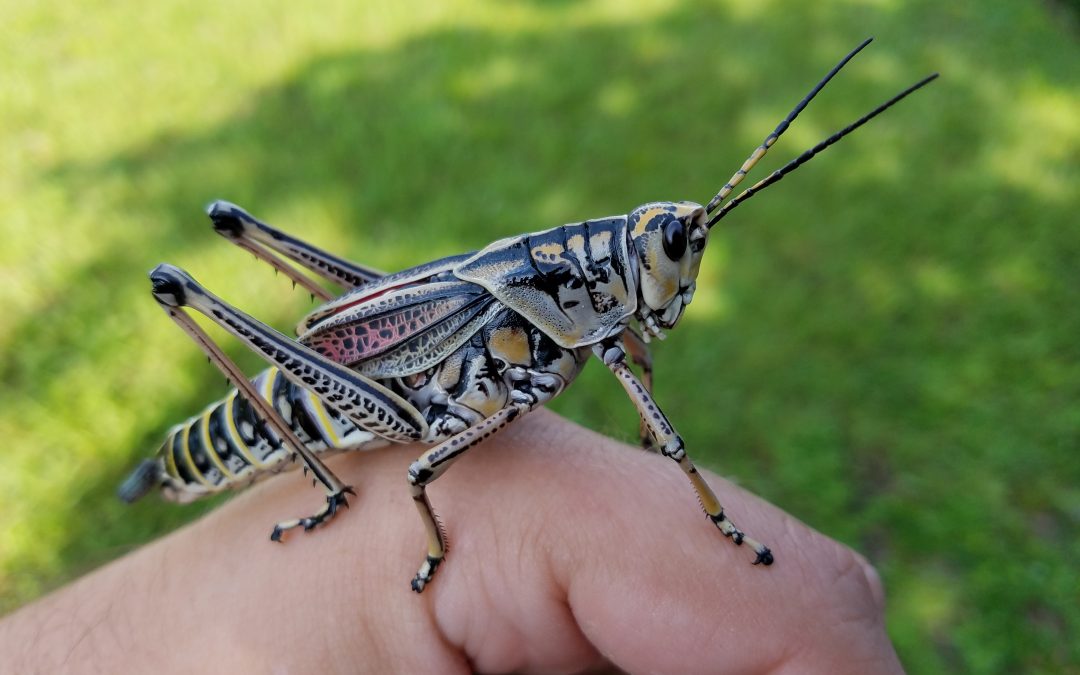
by Evan Anderson | Jun 5, 2025
The Eastern Lubber Grasshopper
From spring to early summer every year, a certain grasshopper can be seen in the Florida panhandle: the eastern lubber, also known as the Georgia thumper. Sometimes emerging in huge numbers, this can be distressing to residents who suddenly find themselves amidst what might appear to be a plague of biblical proportions. Females lay eggs in the soil, and seem to prefer woodland areas with soil that is neither too wet or too dry. With each female laying one or more ‘pods’ of eggs, and each pod containing up to 80 eggs, this can lead to a lot of grasshoppers!
Nymphs are the young and immature form of the grasshopper, and appear different than the adults. Newly hatched lubbers are black with a yellow, orange, or red stripe running down their backs. They range from about ½ inch to 1 ¾ inch long while still in the nymphal stage, and tend to stay together in groups. Adults are seen most often starting in July, growing to a size of up to 3 ½ inches in length. Adults may remain black, but are often seen in lighter colors, from yellow to orange.
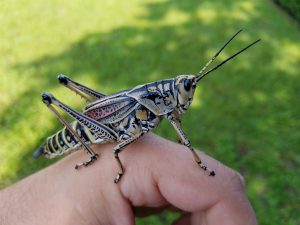
An adult eastern lubber grasshopper.
Eastern lubbers feed on a wide variety of plants. While adults prefer low, wet areas, they will sometimes damage crops or ornamental plants. They eat less than one might expect, given their size, but groups can still defoliate plants if left unchecked. Thankfully, they cannot fly, and therefore do not range over a wide area individually.
If these grasshoppers become a problem in landscapes or gardens, control methods are best undertaken early, while the insects are young. If populations are not great, they can be hand picked and removed. If treatment with insecticide is desired, there are several products available that kill lubbers. For individuals desiring a more ‘natural’ insecticide, products with the active ingredient spinosad are relatively safe to use, if slow acting. Spinosad should be applied in the early morning, late evening, or at night, to avoid affecting foraging pollinators such as bees.
Other insecticides will also work, including those with the active ingredients carbaryl, bifenthrin, cyhalothrin, permethrin, or esfenvalerate. Note that the active ingredient may not be the same as the brand name, and may only be listed in smaller print in the ‘ingredients’ portion of the product’s label. Avoid applying insecticides too close to water bodies, as they may harm fish.
For more information, see the EDIS publication on eastern lubbers at https://edis.ifas.ufl.edu/publication/IN132.
Evan Anderson
Walton County Horticulture Agent
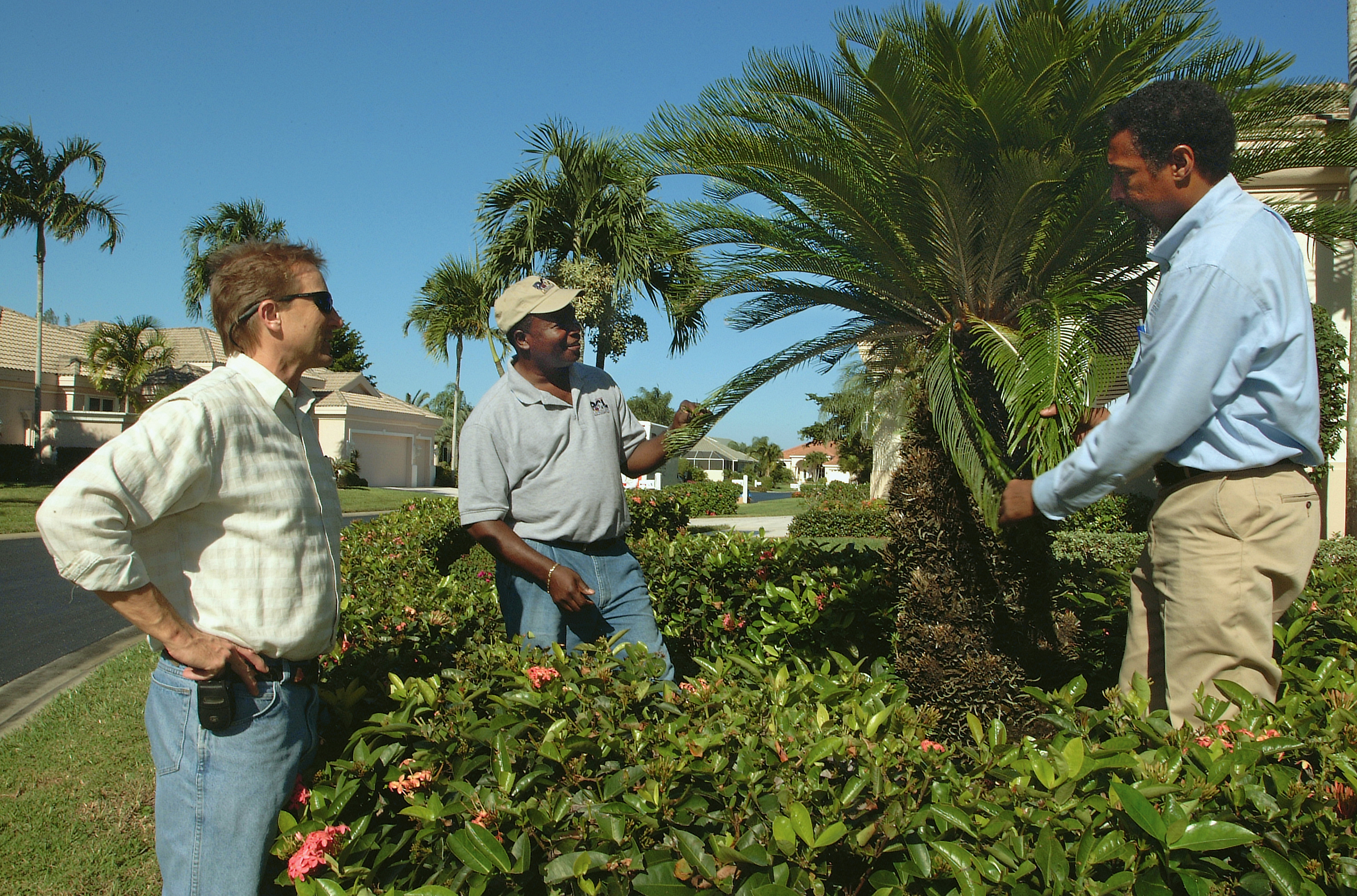
by Matt Lollar | May 28, 2025
Gardening just wouldn’t be any fun without the pests. In this episode of Gardening in the Panhandle LIVE!, the hosts answered some very important questions about different types of pests in Florida lawns and landscapes. Before we talk about some of the specific topics from this episode, it’s critical to know the definition of a pest when it pertains to our yards. A pest is any organism that is harmful and/or damaging to humans or the property of humans such as crops and livestock. Weeds are pests, some insects are pests, and diseases are pests.
Integrated Pest Management or IPM for short is the use of different pest management strategies to help control pests. The UF/IFAS Publication Landscape Integrated Pest Management provides more details on the steps involved in a good IPM program.
As stated above, pests can come in a lot of forms. Pesticides offer control for some pests. The article The Basics of Pesticides provides more information on using pesticides.
“Natural” can be a vague term. You’ll want to read the UF/IFAS publication Natural Products for Managing Landscape and Garden Pests in Florida to help clarify the definition of natural pesticides and offer some natural control options.
If you’re growing edible crops, then you’ll need to follow some extra precautions to make sure your crops are safe to eat. A Florida-Friendly Landscaping Approach to Pest Management in Your Edible Landscape provides IPM strategies specific to fruits, vegetables, and herbs utilized in the landscape.
Some annual weeds are easier to control as the germinate. Pre-emergent herbicides provide a barrier that kills most annual weeds shortly after they germinate. Apply pre-emergent herbicides in late winter before day temperatures reach 65°F–70°F for 4 or 5 consecutive days and in the fall when nighttime temperatures drop to 55°F–60°F for several consecutive days.
The first step of IPM is to scout for pests. More information on scouting can be found in the article Scouting: The tip of the IPM spear from Matt Smith with the UF/IFAS Extension in Lake County.
The larva of many beetle species like to eat turfgrass roots. More information on June beetles and their control can be found in the fact sheet June Beetles (White Grubs).
Ground pearls are very difficult to control. The UF/IFAS publication Ground Pearls, Margarodes spp. (Insecta: Hemiptera: Margarodidae offers detailed information of these underground relatives of armored scales.
Snakes usually help us control pests around our homes. If you’re interested in what snake species live in Florida, then you’ll want to read the UF/IFAS publication Managing Conflicts with Wildlife: Living with Snakes.
Chinch bugs are a major insect pest of Saint Augustinegrass. The UF/IFAS publication Southern Chinch Bug, Blissus insularis Barber (Insecta: Hemiptera: Blissidae) provides some valuable information on this insect pest and how to control it.
Fire ants are a direct pest of humans and the create some unsightly mounds in the yard. A number of baits are available on the market to help keep them out of the landscape. The article Sustainable Fire Ant Control offers more details on baits and other fire ant control strategies.
Mole crickets are another type of insect that feed on turfgrass roots. The Mole Cricket IPM Guide for Florida is a great place to start if you’re trying to understand this pest better.
If you’re sticking with an edible landscape theme, then you’ve certainly encountered leaf-footed bugs and stinkbugs on your fruit and vegetable crops. Larry Williams with the UF/IFAS Extension in Okaloosa County has written a very informative article on leaf-footed bugs titled Leaf-footed Bugs Are Common On Tomatoes.
The extension publication Weed Management Guide for Florida Lawns offers a variety of weed management strategies for your yard.
Weed control in plant beds can sometimes be tricky. The UF/IFAS publication Improving Weed Control in Landscape Planting Beds provides solutions for managing weeds around shrubs and ornamentals.
Products containing glyphosate are good for spot spray applications in the landscape, however some people may choose to avoid its use. The UF/IFAS publication Use of Glyphosate and Herbicide Alternatives for Weed Control in Florida Landscape Planting Beds discusses the advantages and disadvantages of using glyphosate and other herbicides.
Pests can wreak havoc on healthy lawns and landscapes. The resources and advice provided in this episode of Gardening in the Panhandle LIVE! will help you maintain a beautiful setting to enjoy. To view this episode of Gardening in the Panhandle LIVE! please visit our YouTube channel.












